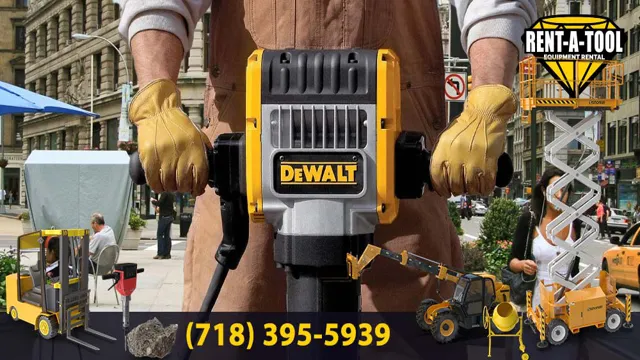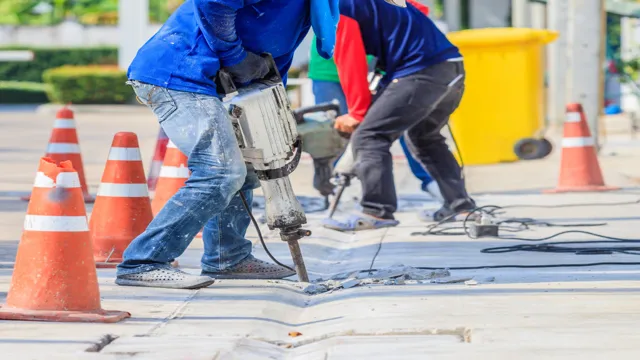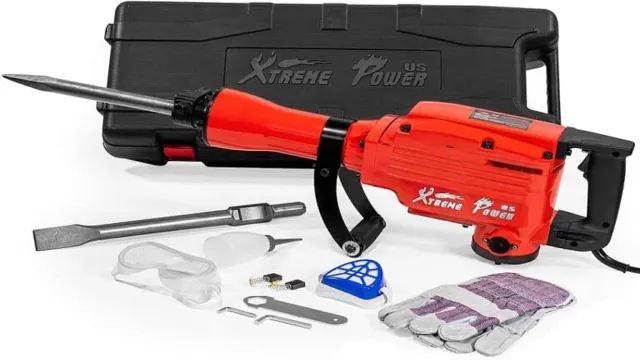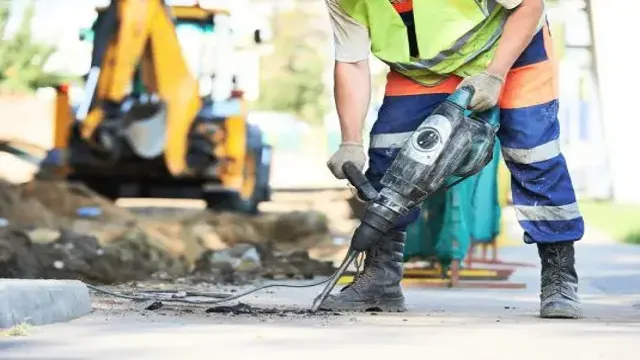How to Fix Jackhammer Rust Easily with These Simple Steps

The jackhammer, a powerful construction tool, is essential in various construction projects. However, constant use and exposure to moisture can cause rust to build up in its metal components. This can weaken the tool and affect its performance.
Don’t fret, though, because fixing jackhammer rust is a manageable task that you can do on your own. In this step-by-step guide, we’ll show you how to restore your jackhammer’s functionality by removing the rust buildup effectively. You don’t need to be an expert to pull this off, but it does require some elbow grease and a few tools.
With our guide, you’ll learn how to clean and inspect the affected areas carefully, remove the rust using various methods, and protect it from future damage. We’ll also share some tips to help you maintain your jackhammer’s performance for longer. So, whether you’re a construction worker, DIY enthusiast, or someone who wants to fix their tools, this guide is for you.
Get ready to roll up your sleeves and restore your jackhammer to its former glory!
Inspect the Rust Damage
If you’re dealing with rust damage on your jackhammer, it’s essential to assess the extent of the damage before fixing it. Inspecting the rusted areas will allow you to determine the exact location and severity of the rust damage. Use a wire brush or sandpaper to remove any loose rust from the surface area.
Then, use a rust converter to turn the remaining rust and create a smooth, clean surface for the new paint to adhere to. Before applying the paint, make sure the surface is completely dry and free of any debris. Utilizing a rust inhibitor paint will help prevent further corrosion and damage.
By taking these steps, you can fix the rust damage on your jackhammer and extend its lifespan in the long run.
Assess the Extent of Rust
When assessing the extent of rust damage, it’s crucial to take a close look at the affected area. Begin by examining the metal surface to check for signs of rust, such as discoloration, roughness, and flaking. Then, try to assess the depth of the rust by probing the surface with a tool or a finger.
If the rust is shallow, it may be possible to remove it with sandpaper or a wire brush. However, if the rust has penetrated deep into the metal, it may require more intensive treatment, such as sandblasting or chemical stripping. Additionally, pay close attention to any areas that are particularly prone to rust, such as joints and edges.
These areas are often more susceptible to rust due to moisture and debris buildup. Overall, a careful inspection of the rust damage is necessary to develop an effective plan for restoration and prevention.

Determine the Type of Rust
When it comes to rust damage, the first step in addressing the problem is determining the type of rust you’re dealing with. There are three main types of rust: flash rust, surface rust, and penetrating rust. Flash rusting occurs when freshly blasted metal is exposed to moisture and oxygen, creating a thin layer of rust.
This type of rust is usually easy to remove and does not cause significant damage. Surface rust is characterized by dry, rough patches on the metal surface. This type of rust is usually superficial and can be removed with a wire brush or sandpaper.
Penetrating rust, on the other hand, is the most damaging type of rust as it has already penetrated through the metal. The affected area is usually flaky, and you may see holes or cracks in the metal. To address this type of rust, the damaged area may need to be cut out and replaced with fresh metal.
By inspecting the rust damage, you’ll be able to determine the best course of action for repairing or replacing the affected metal.
Gather Tools and Materials for Repair
Before you start fixing the rust on your jackhammer, you’ll need to gather some tools and materials to get the job done right. First, you’ll need a wire brush or sandpaper to remove any loose rust or debris from the surface. You’ll also need a rust dissolver to help break up any stubborn rust spots.
Next, pick up some sandblasting equipment to remove the rust from hard-to-reach areas. Be sure to have a pair of gloves to protect your hands during the process and safety goggles to protect your eyes. Along with these tools, you’ll need some primer, paint, and a clear coat to finish the repair job.
Take the time to gather all the necessary materials before starting the repair process to avoid any delays. Once you have everything ready, you’ll be well on your way to fixing the rust on your jackhammer and restoring it to its former glory!
Safety Gear
When it comes to any repair work, safety should be your number one priority. Before you even think about grabbing your tools, make sure you have all the safety gear you need. This includes things like safety glasses to protect your eyes from flying debris and gloves to keep your hands safe from sharp edges.
If you’re working in a noisy or dusty environment, wear earplugs and a dust mask to keep your lungs healthy. Remember, accidents can happen anytime, so it’s crucial to be prepared. Having the right safety gear on hand can make a huge difference in your overall experience and reduce the risk of injury or harm.
Don’t take safety lightly; invest in quality gear to keep yourself protected.
Jackhammer Repair Supplies
If your jackhammer is in need of repair, the first step is to gather all the necessary tools and materials. You will need to have a variety of screwdrivers and wrenches on hand, as well as replacement parts such as bearings, seals, and gaskets. Don’t forget to also purchase lubricant and a cleaning solution to use during the repair process.
Before you begin the repair, it’s important to refer to the manufacturer’s manual to ensure that you have all the necessary tools and materials for your specific model. By taking the time to gather everything you need before starting the repair, you can avoid potential setbacks and ensure that the repair process goes smoothly. With the right tools and materials, you’ll be able to get your jackhammer up and running again in no time.
Prepare the Jackhammer
If you’re dealing with a rusty jackhammer, never fear – with a few simple steps, you can easily fix it up and get back to work. First, prepare the jackhammer by disconnecting the power source and removing any bits or chisels attached to it. Next, use a wire brush or sandpaper to scrub away any loose rust or debris.
For tougher rust, you’ll need a grinder or power tool to grind it away until you see clean metal. Once the rust is removed, use a rust converter to neutralize any remaining rust and prevent it from spreading. Finally, apply a rust-resistant paint or coating to protect the metal and give it a new lease on life.
With these steps, your jackhammer will be as good as new in no time!
Remove the Rust
If you’re working on removing rust, you’ll need to prepare your jackhammer. Jackhammers are powerful tools that can be used for a variety of tasks, including breaking up concrete, removing tiles, and chipping away at rust. But before you start, make sure you’re properly equipped.
Wear protective gear like goggles and gloves, and make sure the jackhammer is properly lubricated. It’s important to choose the right bit for the job at hand. A pointed chisel bit is ideal for removing rust because it can easily chip away at the rust without damaging the underlying metal.
Once you’re ready to start chipping away at the rust, make sure to start at the edges and work your way inward. Take breaks as needed to prevent overheating, and be sure to follow the manufacturer’s instructions for proper use and maintenance. With some patience and a bit of elbow grease, you can remove even the toughest rust with ease.
Clean the Jackhammer
If you want your jackhammer to operate at peak performance, it’s important to clean it regularly. However, before you begin the cleaning process, you need to prepare the jackhammer properly. Firstly, make sure the power source is disconnected to avoid electrocution.
Then, remove all attachments, such as the drill bit and adapters, from the jackhammer. Next, use a brush to remove any major dirt or debris from the tool. Afterward, use a damp cloth to wipe down the body of the jackhammer.
Lastly, make sure the chuck is free of any debris or dirt by wiping it down with a clean cloth. It’s important to note that each type of jackhammer may have specific cleaning protocols, so it’s always best to refer to the owner’s manual for guidance. By taking the time to properly prepare the jackhammer before cleaning, you’ll ensure that it’s ready to tackle any job with ease.
Repair the Rust Damage
If you’ve got a jackhammer that’s showing some rust damage, don’t worry – fixing it is easier than you might think. Firstly, you’ll need to remove all the rust from the affected area using a wire brush. Make sure that you remove all the rust, as even a small amount left behind can continue to corrode.
Once you’ve done this, use a rust converter to neutralize any remaining rust. Then, sand the area with fine-grit sandpaper, and clean it with a damp cloth to remove any dust or debris. Finally, apply a rust-inhibiting primer to the area before painting over it with enamel paint.
By following these steps, you’ll be able to fix your jackhammer and keep it working for years to come. Remember, regular maintenance is key to preventing rust damage in the future, so make sure to take good care of your tool.
Apply Rust Converter
Rust damage on your car can be a major eyesore and can also compromise the structural integrity of the vehicle. Applying a rust converter is an effective way to repair the damage caused by rust. The process involves applying the solution onto the rusted area, which will convert the rust into a black coating that will prevent further corrosion from occurring.
This coating creates a barrier that will stop water, air, and other elements from reaching the metal. The best part is that rust converters can be used on both light and heavy rust, making them a versatile solution to your rust problems. Applying a rust converter can be a simple DIY project and can save you money on costly repairs in the future.
So use a rust converter to repair any rust damage on your car and keep it in pristine condition!
Fill in Any Holes or Cracks with Epoxy
Epoxy If your car has some signs of rust, you may want to repair them to maintain the car’s appearance and prevent the rust from spreading and causing more damage. Filling in any holes or cracks with epoxy is one of the most effective ways to repair rust damage. Epoxy is a versatile and durable material that can be applied to metal surfaces to create a strong and long-lasting bond.
To use epoxy to repair rust damage, you’ll need to clean the affected area thoroughly, removing any loose pieces of rust or debris. Then, mix the epoxy according to the manufacturer’s instructions and apply it to the hole or crack, smoothing it out with a putty knife or other applicator. Once the epoxy has dried completely, sand it down until it’s smooth and flush with the surrounding metal.
This will create a seamless repair that’s both functional and aesthetically pleasing. Overall, using epoxy to repair rust damage is a simple and effective solution that can help your car stay in great shape for years to come.
Paint and Seal the Jackhammer
If you have a rusty jackhammer, don’t worry, it’s relatively easy to fix. The first step is to clean the rust off the surface of the jackhammer. You can use a wire brush or sandpaper to carefully remove the rust.
Once you have removed the rust, you can then paint the jackhammer to prevent further rusting. You should use special paint that is designed for use on metal surfaces. Make sure the paint is applied evenly and allowed to dry completely before moving on to the next step.
The final step is to seal the jackhammer to prevent rust from occurring again. You can use a clear sealant or rust inhibitor to protect the surface. Apply the sealant according to the instructions on the product.
Once you have completed these steps, your jackhammer should be rust-free and ready to use again!
Apply Primer
When it comes to painting and sealing a jackhammer, one of the most important steps is applying primer. Primer helps to prepare the surface of the jackhammer by creating a smooth, even base that the paint can adhere to. Without the use of primer, the paint may not stick properly, resulting in an uneven and unappealing finish.
To apply primer to your jackhammer, first, you will need to clean the surface thoroughly. Use a degreaser and a soft-bristle brush to remove any dirt, oil, or debris. Once the surface is clean, allow it to dry completely before moving on to priming.
Next, apply a thin layer of primer to the jackhammer using a paintbrush or a spray can. Follow the manufacturer’s instructions regarding drying time before applying additional coats of primer or paint. Generally, it’s recommended to apply at least two coats of primer, allowing each coat to dry completely before applying the next.
Remember to always wear protective gear, such as gloves, goggles, and a mask, when working with paint and primer to avoid any potential harm. With the proper technique and the use of primer, you can ensure that your jackhammer is sealed and painted to perfection, ready for any job that comes your way.
Paint the Jackhammer
When it comes to maintaining your jackhammer, keeping the paint and seal in tip-top shape is crucial. Not only does a fresh coat of paint make your tool look better, but it also helps protect it from rust and other damage. Before painting, make sure to clean the surface of your jackhammer thoroughly, removing any debris or dirt.
Once cleaned, apply a layer of primer to help the paint adhere properly. When choosing a paint, opt for a durable, weather-resistant option that can handle the wear and tear of heavy use. To seal the paint and protect against corrosion, finish with a clear topcoat.
Taking the time to paint and seal your jackhammer will not only increase its longevity but also improve its overall performance.
Seal with Clear Coat
Once you’ve finished painting your jackhammer, the next important step is to seal it with a clear coat. Not only does this add an extra layer of protection to the paint, but it also gives it a nice glossy finish. Choose a clear coat that is specifically designed for outdoor use and is compatible with the type of paint you used.
Before applying it, make sure your painted surface is clean and dry. Use a high-quality brush or spray can for an even application and work in thin, consistent coats. Wait for each coat to dry before applying the next one and avoid spraying in direct sunlight or high humidity.
Once you’re done, allow the clear coat to cure completely before handling your jackhammer. Adding a clear coat will not only enhance the appearance of your jackhammer but also prolong its life. Don’t forget, proper maintenance is key to keeping your tools in great condition.
Conclusion
Don’t let rust give your jackhammer the shaft! With a little TLC and some elbow grease, you can revive your trusty tool in no time. Whether you choose sanding, painting, or rust remover, just remember to address the problem before it spreads like a virus. Give it some love, and your jackhammer will be breaking ground like new in no time! After all, a rusty jackhammer is like a bad joke- it just doesn’t work.
“
FAQs
What causes rust in jackhammers?
Rust in jackhammers can be caused by exposure to moisture, humidity, or environmental factors such as saltwater or chemicals.
How can I prevent rust in my jackhammer?
You can prevent rust in your jackhammer by keeping it dry, avoiding exposure to moisture and humidity, and storing it in a dry, cool place when not in use. You can also apply a rust inhibitor or lubricant to the tool.
Can I fix rust on my jackhammer myself?
Yes, you can fix rust on your jackhammer yourself by sanding off the rusted area with sandpaper or a wire brush, applying a rust remover, and then applying a rust inhibitor or paint to prevent further rusting.
What should I do if the rust on my jackhammer is severe?
If the rust on your jackhammer is severe, you may need to replace the affected parts or take it to a professional for repair.
How often should I inspect my jackhammer for rust?
You should inspect your jackhammer for rust regularly, at least once a month, to catch any rust early and prevent it from spreading.
Can I use my jackhammer if it has rust on it?
It is not recommended to use a jackhammer with rust on it as it can affect the tool’s performance and potentially cause safety hazards.
How long does it take for rust to damage a jackhammer?
The time it takes for rust to damage a jackhammer can vary depending on the severity of the rust and how often the tool is used. It is best to catch rust early and prevent it from spreading to avoid any damage.







